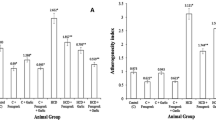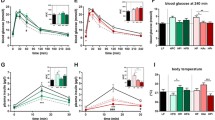Abstract
Background
LDL (low-density lipoprotein) oxidation is a key trigger factor for the development of atherosclerosis. Relatively few studies exist on the impact of dietary fibre on LDL oxidation. This study was undertaken to evaluate the influence of a novel fibre mix of fenugreek seed powder, guar gum and wheat bran (Fibernat) on LDL oxidation induced by an atherogenic diet.
Method
Male Wistar albino rats were administered one of the following diets: (1) a control diet that was fibre-free (Group I); (2) an atherogenic diet containing 1.5% cholesterol and 0.1% cholic acid (Group II) or (3) an atherogenic diet supplemented with Fibernat (Group III). Peroxidative changes in low-density lipoprotein (LDL) and the oxidative susceptibility of LDL and the LDL + VLDL (very low-density lipoprotein) fraction were determined. As a corollary to the oxidative modification theory, the titer of autoantibodies to oxidised LDL (oxLDL) was determined at various time points of the study. In addition, plasma homocysteine (tHcy) and lipoprotein (Lp (a)), apolipoprotein (apoB), cholesterol, triglyceride, phospholipid and α-tocopherol content of LDL were determined.
Results
A decrease in malonaldehyde (MDA) content (p < 0.05) and relative electrophoretic mobility (REM) of LDL was observed in the group III rats as compared to the group II rats. An increase in lag time to oxidation (p < 0.01) and decrease in maximum oxidation (p < 0.01) and oxidation rate (p < 0.01) were observed in the LDL + VLDL fraction of group III rats. In group II rats, formation of autoantibodies to oxLDL occurred at an earlier time point and at levels greater than in the group III rats. Fibernat, had a sparing effect on LDL α-tocopherol, which was about 51% higher in the group III rats than in the group II rats; apo B content of LDL was reduced by 37.6% in group III rats. LDL of group III rats displayed a decrease in free and ester cholesterol (p < 0.01) as compared to that of group II. A decrease in plasma homocysteine (p < 0.01) and an increase in GSH (p < 0.05) were also observed in group III rats when compared with that of group II.
Conclusion
Fibernat administration appears to combat oxidative stress resulting in a trend to lower oxidative modification of LDL. In addition, the cholesterol and apo B content of LDL were reduced significantly with a sparing effect on LDL α-tocopherol. This novel fibre preparation could be an effective diet therapy and therefore needs further investigation.
Similar content being viewed by others
References
Witztum JL, Steinberg D (2001) The oxidative modification hypothesis of atherosclerosis. Does it hold for humans? Trend Cardiovasc Med 11: 93–102
Sato K, Niki E, Shimasaki H (1990) Free radical mediated chain oxidation of low-density lipoprotein and its synergistic inhibition by vitamin E and vitamin C. Arch Biochem Biophys 279: 402–405
Aviram M, Dornfeld L, Rosenblat M, Volkova M, Kaplan M, Coleman R, Hayek T, Presser D, Fuhrman B (2000) Pomegranate juice consumption reduces oxidative stress, atherogenic modifications to LDL and platelet aggregation: studies in humans and in atherosclerotic apolipoprotein E-deficient mice. Am J Clin Nutr 71: 1062–1076
Vergara -Jimenez M, Furr H, Fernandez ML, (1999) Pectin and psyllium decrease the susceptibility to LDL oxidation in Guinea pigs. J Nutr Biochem 10: 118–124
Venkatesan N, Devaraj SN, Devaraj H (2003) Increased binding of LDL and VLDL to apo B, E receptors of hepatic plasma membrane of rats treated with Fibernat. Eur J Nutr 42: 262–271
Bajwa GS, Morrison LM, Ershoff BM (1971) Induction of aortic and coronary atherosclerosis in rats fed a hypervtaminosis D, cholesterol containing diet. Proc Soc Exp Biol Med 138: 975–982
Chung BH, Wilkinson T, Geer JC, Segrest JP (1980) Preparative and quantitative isolation of plasma lipoproteins: rapid, simple discontinuous density gradient ultacentrifugation in a vertical rotor. J Lipid Res 21: 284–291
Desai ID (1984) Vitamin E analysis methods for animal tissues. Meth Enzymol 105: 138–147
Esterbauer H, Zadravec SZ, Slater F (1984) Detection of malonaldehyde by high-performance liquid chromatography. Meth Enzymol 105: 319–328
Klein RA (1984) The detection of oxidation in liposome preparation. Biochim Biophys Acta 210: 486–489
Damasceno NRT, Goto H, Rodrigues FMD, Dias CTS, Okawabata FS, Abdalla DSP, Gidlund M (2000) Soy protein isolate reduces the oxidizability of LDL and the generation of oxidized LDL autoantibodies in rabbits with diet-induced atherosclerosis. J Nutr 130: 2641–2647
Burstein M, Scholnick HR (1973) Lipoprotein – polyanion metal interactions. Adv Lipid Res 11: 68–108
Wallin B, Rosengren B, Shertzer HG, Camejo G (1993) Lipoprotein oxidation and measurement of thiobarbituric acid reacting substances formation in a single microtiter plate – its use for evaluation of antioxidants. Anal Biochem 208: 10–15
Okhawa M, Ohishi N, Yagi K (1979) Assay for lipid peroxides in animal tissues by thiobarbituric acid reaction. Anal Biochem 95: 351–358
Moron MS, Defierre JW, Mannervik KB (1979) Levels of glutathione reductase and glutathione-S-transferase activities in rat lung and liver. Biochem Biophys Acta 582: 67–74
Bennani-Kabchi N, Kehel L, El Bouayadi F, Fdhil H, Amarti A, Saidi A, Marquie G (2000) New model of atherosclerosis in insulin-resistant sand rats: hypercholesterolemia combined with D2 vitamin. Atherosclerosis 150: 55–61
Joris I, Zand T, Nunnari JJ, Krolikowski FJ, Majno G (1983) Studies on the pathogenesis of atherosclerosis. Adhesion and emigration of mononuclear cells in the aorta of hypercholeasterolemic rats. Am J Pathol 113: 341–358
Barbeau ML, Whitman SC, Rogers KA (1995) Probucol, but not MaxEPA fish oil, inhibits mononuclear cell adhesion to the aortic intima in the rat model of atherosclerosis. Biochem Cell Biol 73: 283–288
Grundy SM, Denke MA (1990) Dietary influences on serum lipids and lipoproteins. J Lipid Res 31: 1149–1172
Carr TP, Parks JP, Rudel LL (1992) Hepatic ACAT activity in African Green monkeys is highly correlated to plasma cholesteryl ester enrichment and coronary artery atherosclerosis. Arterioscler Thromb 12: 1274–1283
Cos E, Ramjiganesh T, Roy S, Yoganathan S, Nicolosi RJ, Fernandez ML (2001) Soluble fiber and soybean protein reduce atherosclerotic lesions in guinea pigs. Sex and hormonal status determine lesion extension. Lipids 36: 1209–1216
Veniant MM, Zlot CH, Walzem RL, Pierotti V, Driscoll R, Dichek D, Herz J, Young SG (1998) Lipoprotein clearance mechanisms in LDL receptor-deficient “Apo B-48 only”and “Apo B-100 only” mice. J Clin Invest 102: 1559–1568
Diniz YS, Cicogna AC, Padovani CR, Silva MD, Faine LA, Galhardi CM, Rodriguez HG, Novelli EL (2003) Dietary restriction and fibre supplementation: oxidative stress and metabolic shifting for cardiac health. Can J Physiol Pharmacol 81: 1042–1048
Rezar V, Pajk T, Logar MR, Janezic JV, Salobir K, Oresnik A, Salobir J (2003) Wheat bran and oat bran effectively reduce oxidative stress induced by a high fat diets in pigs. Ann Nutr Metab 47: 78–84
Jenkins DJ, Kendall CW, Vidgen E, Mehling CC, Parker T, Seyler H, Faulkner D, Garsetti M, Griffin LC, Agarwal S, Rao AV, Cunnane SC, Ryan MA, Connelly PW, Leiter LA, Vuksan V, Josse R (2000) The effect of serum lipids and oxidized low-density lipoproteins of supplementing self-selected low-fat diets with soluble fiber, soy and vegetable protein foods. Metabolism 49: 67–72
Steinbrecher Urs P, Zhang H, Lougheed M (1990) Role of oxidatively modified low-density lipoproteins in atherosclerosis. Free Rad Biol Med 9: 155–168
Araujo FB, Barbosa DS, Hsin CY, Maranhao RC, Abdalla DSP (1995) Evaluation of oxidative stress in patients with hyperlipidemia. Atherosclerosis 117: 61–71
Rajendran S, Kamaravelu P, Putchen DD, Devaraj SN (1996) Protective effect of Tincture of Cratageus on oxidative stress in experimental atherosclerosis in rats. J Clin Biochem Nutr 20: 211–233
Larauri JA, Ruperez P, Calixto FS (1996) Antioxidant activity of wine pomace. Am J Eno Viti 47: 369–372
Filipek J (1992) The effect of the mushroom Pleurotus ostreatus on the lipid peroxidation of phosphatidylcholine liposomes. Pharmazie 47: 393
Wild SH, Fortmann SP, Marcovina SM (1997) A prospective case control study of lipoprotein (a) size and risk of coronary heart disease in Stanford Five city project participants. Arterioscler Thromb Vasc Biol 17: 239–245
Sainani GS, Sainani R (2002) Homocysteine and its role in the pathogenesis of atherosclerotic vascular disease. J Assoc Phys India 50: 5–8
Mennen LI, de Courcy GP, Guilland J-C, Ducros V, Bertrais S, Nicolas JP, Maurel M, Zarebska M, Favier A, Franchisseur C, Hercberg S, Galan P (2002) Homocysteine, cardiovascular disease risk factors, and habitual diet in the French Supplementation with Antioxidant Vitamins and Minerals Study. Am J Clin Nutr 76: 1279–1289
Dusitanond P, Eikelboom JW, Hankey GJ, Thom J, Gilmore G, Loh K, Qi Y, Klijn CJM, Langton P, Van Bockxmeer FM, Baker R, Jamrozik K (2005) Homocysteine-lowering treatment with folic acid, cobalamin, and pyridoxine does not reduce blood markers of inflammation, endothelial dysfunction, or hypercoagulability in patients with previous transient ischemic attack or stroke. A randomized substudy of the VITATOPS trial. Stroke 36: 144–146
Acknowledgments
The authors are grateful to the University Grants Commission for their Special Assistance Programme, Council of Scientific and Industrial Research, New Delhi, and Sterling Health Care Private Limited for providing study samples of Fibernat.
Author information
Authors and Affiliations
Corresponding author
Rights and permissions
About this article
Cite this article
Venkatesan, N., Devaraj, S.N. & Devaraj, H. A fibre cocktail of fenugreek, guar gum and wheat bran reduces oxidative modification of LDL induced by an atherogenic diet in rats. Mol Cell Biochem 294, 145–153 (2007). https://doi.org/10.1007/s11010-006-9254-z
Received:
Accepted:
Published:
Issue Date:
DOI: https://doi.org/10.1007/s11010-006-9254-z




